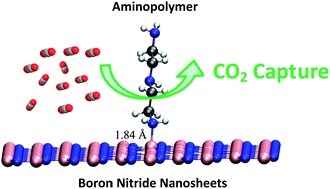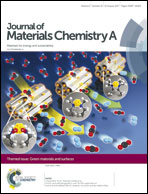Aminopolymer functionalization of boron nitride nanosheets for highly efficient capture of carbon dioxide†
Abstract
Boron nitrides (BNs) are a class of materials with unique properties that exhibit promise for applications in CO2 capture. However, the surface electron-deficiency of BNs makes their interaction with Lewis acidic CO2 very weak. By utilizing the strong interaction between electron-deficient boron atoms and electron-donating amine groups, BN nanosheets were functionalized with polyethyleneimine (PEI) which is rich in amine density, through simple impregnation to improve their performance for CO2 capture. The important roles of the boron–amine interaction in the incorporation, distribution and stabilization of PEI, as well as the facilitation of CO2 adsorption and desorption were both experimentally and theoretically investigated. It is demonstrated that after functionalization with PEI, the capacity of pure CO2 on BN nanosheets was significantly improved (3.12 mmol g−1 for BN functionalized with 54.9 wt% of PEI vs. 0.29 mmol g−1 for pristine BN at 75 °C). Furthermore, the adsorbed CO2 can be facilely released through N2 purge at 75 °C, and the PEI-functionalized BN nanosheets exhibit high stability throughout consecutive cycles.

- This article is part of the themed collection: Green Materials and Surfaces


 Please wait while we load your content...
Please wait while we load your content...